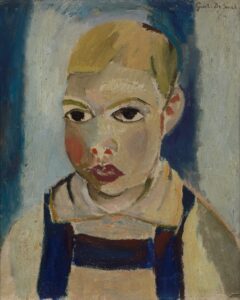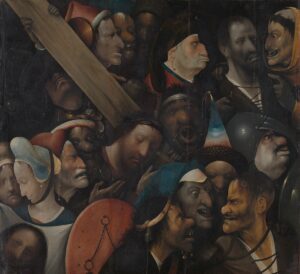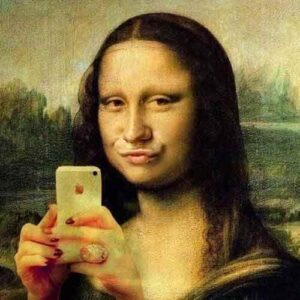
Sam Vangheluwe

I need a new office chair. My current one tends to start descending slowly as soon as I sit down. As the distance between my nose and the tabletop sustainedly decreases, confidence in what I write diminishes, and insecurity grows. At the lowest point, I am more liable to mess about with the stationary than put concrete thoughts to paper. Just try to formulate an intelligent idea with your chin on the table’s edge: it is fairly impossible.
Requiring utmost concentration, this position forces the writer to stick to what is essential. That is why, especially for this contribution, I have decided to refrain from pumping up the gas lift every minutes or so. Also, I am writing this by means of a stub of a pencil, to enhance humility and conciseness.
Recently I read an analysis of the last decades of European painting. Apparently, European painting since the 1980s is called ‘New European Painting’. You don’t say. Allegedly, it is characterized by ‘new figuration’. As a reaction against American abstraction. I didn’t know that. Neither was I aware that the modernism of Abstract Expressionism ‘rejected our own history and tradition’. Our ‘own history’ seems to refer to the European post-war (and colonial) period.
In contrast, I am very aware of the ‘postmodern archive fever’ of the New European Painter (NEP) – the ‘flood of images, new media and its effects on image theory and therefore on painting’. The NEPs feverishly collect second-hand imagery, a child knows that. At the start of day, the New European (or, by now, New Figurative) Painter enters his studio, takes a deep breath, and opens an image folder on his laptop. Searching for Godot. What I do not get is the link between this kind of figuration and the multiple references to the tradition of Northern European Painting, quote: the “Old Master like manner”.
The author (Julien Delagrange) concludes that:
[…] the foundation and character, rooted in the first two generations of this movement [sic, NEP] remains true with the current generation of European painters building upon the works of their contemporary predecessors [sic]. This foundation is based on their historic connection of the tradition of European naturalistic painting and (recent) European history [sic, sic].
Very quaint, all that. History Painting revisited? Retour à l’ordre all over again?
As a young ’un, at the Academy of Fine Arts, I vaguely expected that I would learn to paint. Boosted by an unwavering belief in my innate talent, I set forth to conquer the art world. Through hard work, good intentions, patience, insight and inspiration, I would prove my indubitable worth, and stake my claim among countless rivals, small and big, young and old, living and dead – and prevail.
If I remember well, I was quite cavalier about the how – after all, what is talent for? As to the what, I must have obscurely presumed that the raison d’être for my world-conquering oeuvre would be informed by the outside world – my endless supply of subject matter. My painting would acquire significance from a tasteful or clever choice of subject, and my virtuoso yet somewhat enigmatic depiction thereof. Done. In the can.
After oodles of still-lives with baskets and copper lamps, legions of nudes, landscapes, interiors, portraits, cats, dogs and ducks, worry set in. Soon, concern grew to torment.
The Academy had taught me nothing except how to convince a jury. Any presumed talent got me nowhere. Wholly redundant. Neither how nor what had been answered, nor why, for that matter, and I began to suspect that they never would. And reality was rapidly receding out of reach.

c1560
In the meantime, the art world became increasingly unfamiliar, and painting was in crisis. The last large painterly upsurge I was aware of as a student was that of the Neue Wilde. Conceptual art was at a high. Alternatively, graffiti and graffiti-inspired painting was gaining terrain. As a rule, art criticism was either dumb or quintessentially abstruse (mostly both). Once again, painting was at death’s door, or already deceased.
The era of amateurism had kicked in. As ever fewer painters made the grade, the interest of society at large awakened. Everyone is an artist. La Rivoluzione siamo Noi, as Beuys had wanted it.
It did not occur to my grandfather, a Sunday painter, bless his memory, to put some flowers in a vase and paint them. He too was infatuated with the second-hand image. But, whereas once a diligent amateur painter had to copy the second-hand image (a postcard, most often), by means of gridlines, or worse, messing about with a pantograph, for a good decade now art supply shops have been well-stocked with various brands and models of ‘art projectors’ – latterly being superceded by the digital beamer. Every soul now owns a smartphone and is connected to the Web. Any moderately gifted simian has access to this deluge of images, and can fancy having a grasp of reality.
Only insofar as my granddad could not rely on the archive of second-hand images, i.e. in his ‘errors’: crooked anatomy, erratic perspective, etc., his painting was true, and closer to the ‘Old Master-like manner’ than he could ever have grasped.
Northern European painting – the Old Masters – did not copy or represent pre-existing reality, but constantly reinvented reality, and we seem collectively to have forgotten this. NEP certainly has. Medieval painting embodies the profound unity between man and the world. Centuries of rationalism have divorced man from his universe; he no longer participates in it, and thus he becomes a naturalistic painter. In the late history-and-tradition-denying Modernist painting, there was at least the opportunity of questioning reality – indeed, of creating it.
Only because painting refuses to acknowledge a single, given, conventional reality, is it able to thwart the many announcements of its (impending) demise. Painting creates reality, whereas photography captures 1/125th of a second or so, of a type of monocular reality that is subject to conventionally engineered optical materials and (now) digital software. Yet hundreds of thousands of amateurstogether with a handful of ‘professionals’, prefer to rely on the second-hand image as an ‘objective’ view of a singular, frozen, exclusive reality. ‘The contemporary equivalent of drawing,’ as it is said to be. The outside world remains safely outside, with everything securely in its designated place, and the painter can claim to ‘express’ his deepest feelings, or worse, thoughts, based on a snapshot. In the same breath, the painter has relinquished his bond with the world, with the elements, in exchange for a long-term infatuation with optical technology.

It is enough to convince one that painting has indeed finally expired. Painting is constantly being degraded to image. Images are worshipped, whereas paintings, more often than not, are overpowered, threatened. Set upon with words, reduced by reproduction, subdued by exhibition concepts, tainted by restoration. The world has an insatiable appetite for images, but it dismisses painting. Painting is unwieldy, not easily digested, too disorienting, confronting. It is too free by far, and then some – despite all appearances.
That is why painters burden their works with ‘messages’ (if they don’t, someone else surely will). It explains why museum visitors read texts or listen to a (recorded) guide, rather than contemplate the painting one-to-one, guilelessly. It is why painters try to prove something with their painting (if they don’t, they will be called to account). It explains why painters fret about the historical relevance of their work. It is why they spurn unpredictable nature in favor of safe, reassuring second-hand imagery that releases their disquieting ties with the world that is in and around them. It is why there are currently only two accepted ontological states of painting: either (1) a ‘representation’ of pre-existing reality (Godot); or (2) a decoration or adornment (denial of Godot).
These are hard times for renegade European painters. Nowadays, quorums of artists are conceived and launched as investment products, distributed among the haves by a handful of supercilious galleries, promulgated by and glorified in museums. There is no healthy art market: ‘ordinary’ people make do with wall decorations from Ikea. And the middle-classes unquestioningly adopt the prevailing discourse.
In its heyday, (European) painting grew out of inability, absence, the impossibility of painting, non-virtuosity, as acknowledged with more or less frankness, and sometimes with insistence, by painters such as Georges Braque, Henri Matisse, Alberto Giacometti, Jean Bazaine, Bram van Velde.
Claiming access to Godot is futile, indeed risky, as is the insouciance sought for by means of wilful ignorance. Reality is not outside, not given, not singular, not a stockpile of props, an archive of second-hand images from which to choose at leisure. It is within and beyond us. A painter must not think of his era. He must not fancy himself embedded within any historical tradition. Painting does not equal bearing a message. A painter must stay within his painting, as it leads him and not the other way round. Painting has nothing to prove. It must merely exist. Painting is utterly impossible, and therefore one must paint. Unarmed, defenceless, vulnerable. Try again. Fail again. Fail better. It is our birthright.
For the CAI article by Julien Delagrange (himself NEP, and CAI Gallery director), see:
https://www.contemporaryartissue.com/post/new-european-painting

